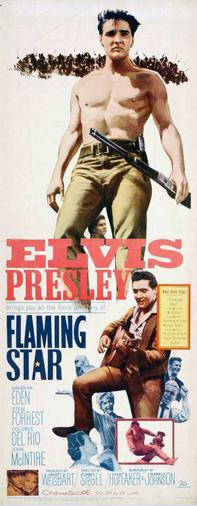Development
The film was based on Clair Huffaker's novel Flaming Lance, which was published in 1958. [8]
Film rights were purchased by 20th Century Fox and Nunally Johnson was assigned to write the script. It was originally titled The Brothers of Flaming Arrow, then Flaming Lance. [9] In May 1958, Fox announced that a film version would start shooting the following month. [10] Johnson later recalled that the studio "said they couldn't make it because it would cost too much for a Western and a Western couldn't get in as much as it would cost, something like that." [11]
Huffaker was asked to make rewrites. "I took two weeks rewriting the script and only ten days of the book," he said. "I hate to say it, but in rewriting the script, I think it makes a better story than my original." [12]
Frank Sinatra and Marlon Brando were originally slated to play the brothers [13] before Fox decided to cast Presley in the lead role. [13] Presley's previous film, G.I. Blues , had been a success at the box office and had led to one of his best-selling albums. [14] Determined to be taken seriously as an actor, though, Presley asked for roles with fewer songs. [13]
"Physically he's right," said producer David Weisbart, who had produced Presley's first film, Love Me Tender . "His Army training and the athletic interests he picked up there have left him in superb condition. He probably always was graceful... but now his grace is trained and refined and developed. What's more his slight Mississippi accent is no problem in a film set in West Texas." [15]
Director Don Siegel shot tests with Presley wearing dark contact lenses, but decided that they detracted from Presley's acting too much and discarded them. [15]
Fox insisted on the addition of four songs. "We aren't courageous enough to present him without any songs at all," said Weisbart. [15] "We've spotted them [the songs] where they'd come in naturally," said Weisbart. " At a frontier party, at an encampment, and during a horseback ride over the plains." [15]
Fox wanted a theme song, so Huffaker changed the title to Black Star, which he felt would be more fitting for a song than Flaming Lance would be. He concocted an old Indian legend about a black star. "It was OK to change the title and have a song written about a star," he said. [12]
Presley recorded a theme song, but it was later rerecorded as "Flaming Star", using the same words and melody. [16] [17]
Flaming Star was initially to include four songs. Siegel wished that Presley not appear "professional" in those scenes: "He should have an awkwardness and an absence of the Presley mannerisms." [18] Eventually, Presley demanded that two songs be removed, leaving just the title song and a short number at the opening birthday party scene. [13] Despite Presley's aforementioned desire to make films with fewer songs, this would be the last of his films to have a minimal number of songs until the 1969 release, Charro! , coincidentally his next western, had only a title song featured.
Johnson was contacted when abroad by Huffaker, who had written the original novel. He told Johnson that Presley was cast and wanted know if Johnson objected to Huffaker having credit on the script. "I'd always objected to that, but I couldn't say no to the guy," said Johnson. "He didn't do anything, as he admitted. I was wondering what in God's name they would do with Elvis Presley in this. All they did was put in a kind of a hoedown dance and Presley sang a song at the opening and then they went right on into the picture." [11]
